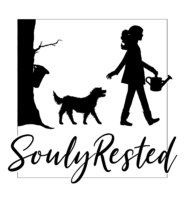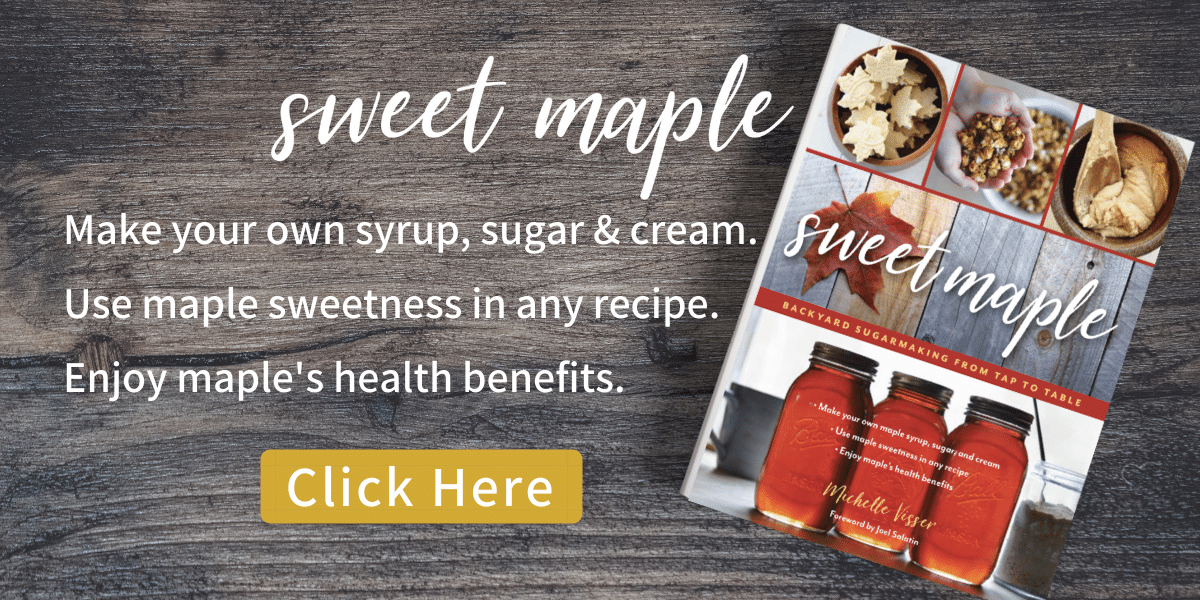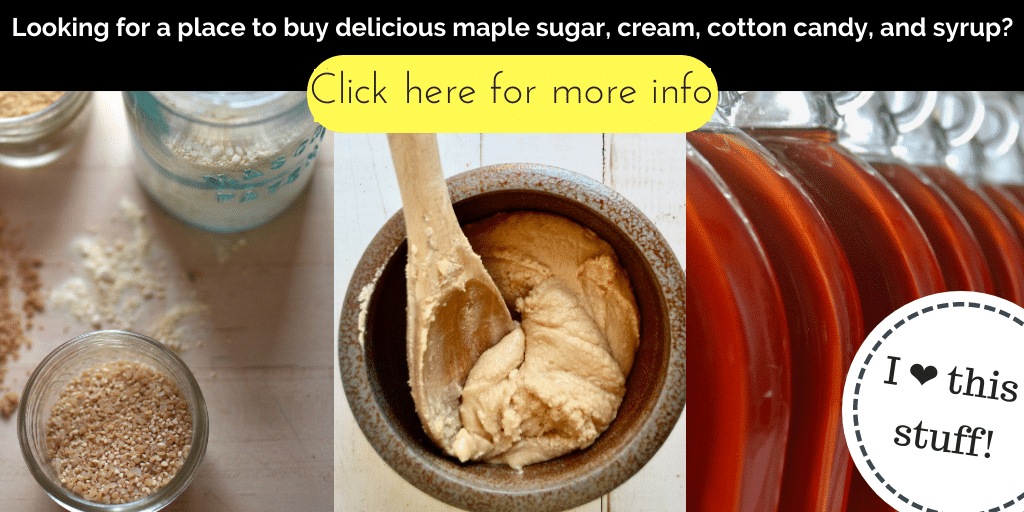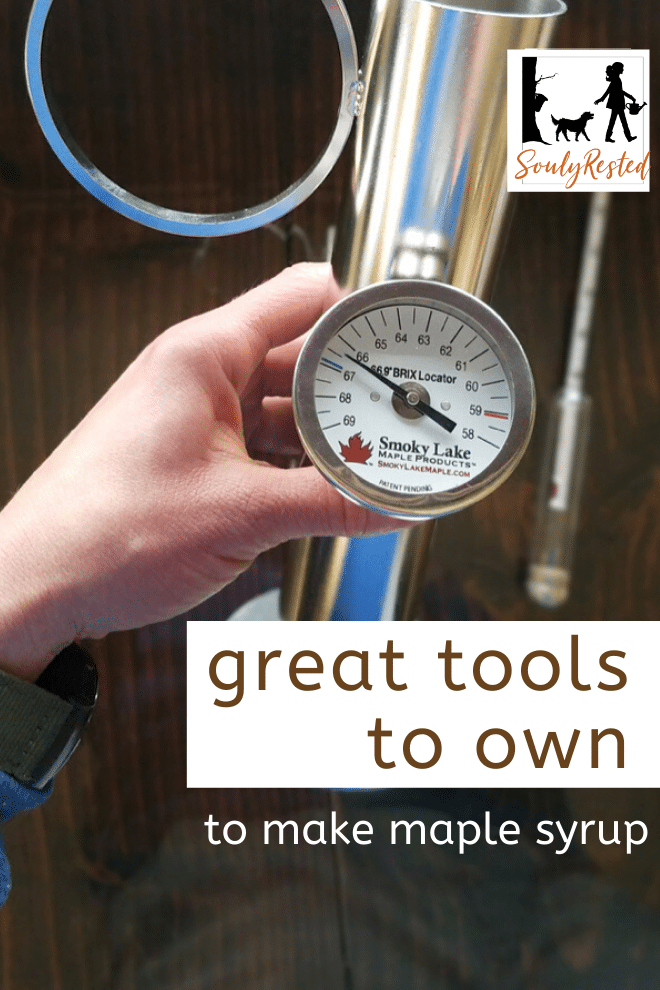Last Updated on February 18, 2024 by Michelle
It seems the question I get the most about how to make syrup is a pretty simple one–“What tools do I need?”
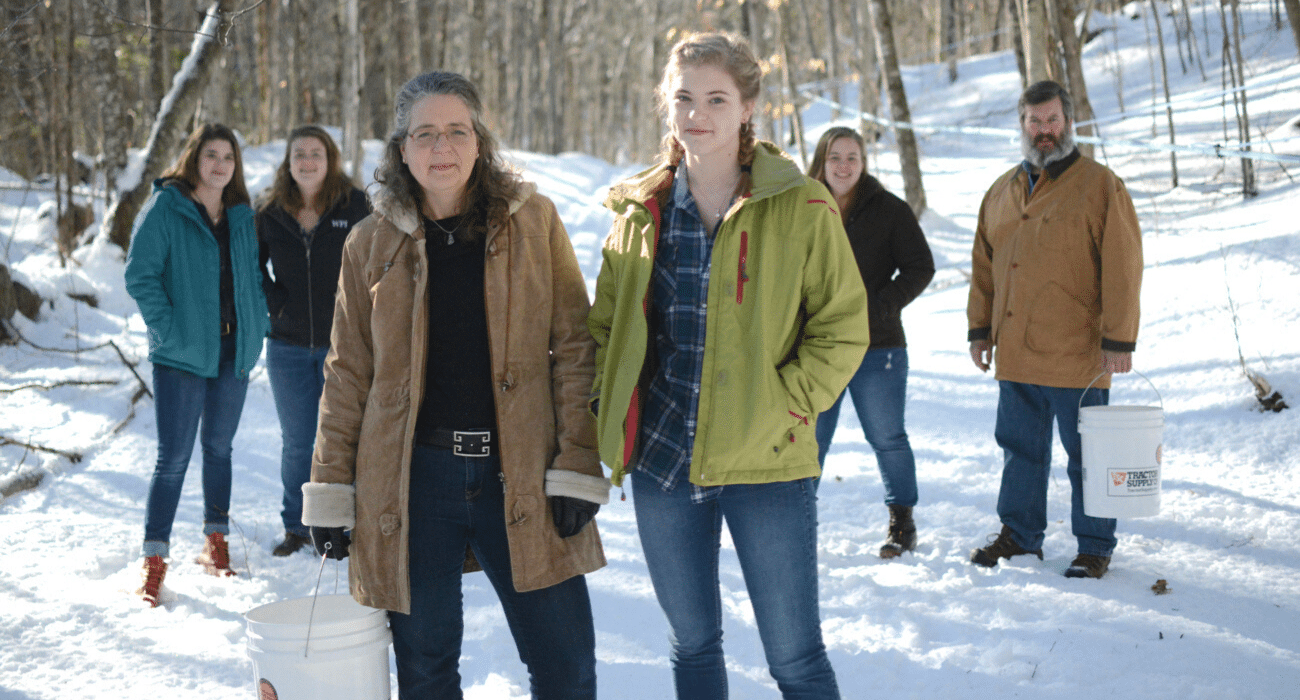
If you’re just trying this out and only tapping a few trees for fun, you can keep it very low key. A few taps and buckets and a large pan over the fire should do it. When it’s time to bottle your syrup, a simple candy thermometer can help you test the temperature and know when to bottle it. Go here to see the taps, buckets, and thermometer I recommend.
If you want to make a hobby out of making syrup, you will very soon realize you want to have the best tool to test your sugar content, to make sure you’re bottling it at the perfect point.
So it’s one of the Million Dollar Questions in the world of backyard sugarmaking… “How do you test your brix?” If you have no idea what I’m talking about, I’ll explain below.
Go here for step-by-step directions on how to make syrup, or take a listen to the podcast episode I recorded all about the 8 Steps From Sap to Syrup. (Or go here for a link to listen on your favorite podcast player.)
And grab a copy of my book, Sweet Maple, or my course, Making Maple Sugar, if you want to know every detail about all things maple.
How to make syrup — and “measure the brix.”
To have the best syrup, you want to know when it’s boiled down to the perfect thickness. Or, another way to say it is that you want to boil off just the right amount of water to leave you with the perfect amount of sugar.
To know when you’ve reached syrup perfection, you need to take a simple measurement. In the syrup world, it’s called “brix.” The brix–or the perfect amount of sugar–is 66-68 (or 66-68% sugar). At that stage, you have yourself some genuine good syrup; not too runny & not too thick.
So how do you measure the brix? This is one of those questions. A question that is always debated and never solved to everyone’s agreement. But that’s okay, because most backyard enthusiasts have one tool that they stick with, because they’re not overly particular and it works for them. Professional sugarmakers, on the other hand, have a very definite opinion of the best tool to use. Sometimes they have a very specific combination of tools that they use, in a very precise manner, every time.
How to make syrup–what tools measure the brix?
Without arguing it to the death–cause well I don’t really care what tool we use, as long as I have maple syrup in my root cellar all year long, ya know what I’m saying?–I will describe the tools that will help you have perfectly boiled syrup. Which you should use, well, that’s the $20,000 question.
Here’s a break down of how these nifty tools work.
Hydrometer
To use a hydrometer, you fill the tall metal cup, which you purchase with your hydrometer (but usually as a separate purchase) with your syrup that you’re boiling. Then gently place your hydrometer in the filled cup (with a plate underneath to catch any overflow). It will float, and when it finishes bobbing in the syrup, you can read the measurement on the hydrometer at the line of your syrup. If the red line is even with the surface of your syrup in the cup, you’re ready to bottle.
If your brix reading is too low, and the red line floats below the surface of the syrup, you need to keep boiling your sap and try measuring it again in a little bit. If, on the other hand, your brix reading is too high, mix in a little partially-boiled sap, cook the syrup a little bit longer and retest it.
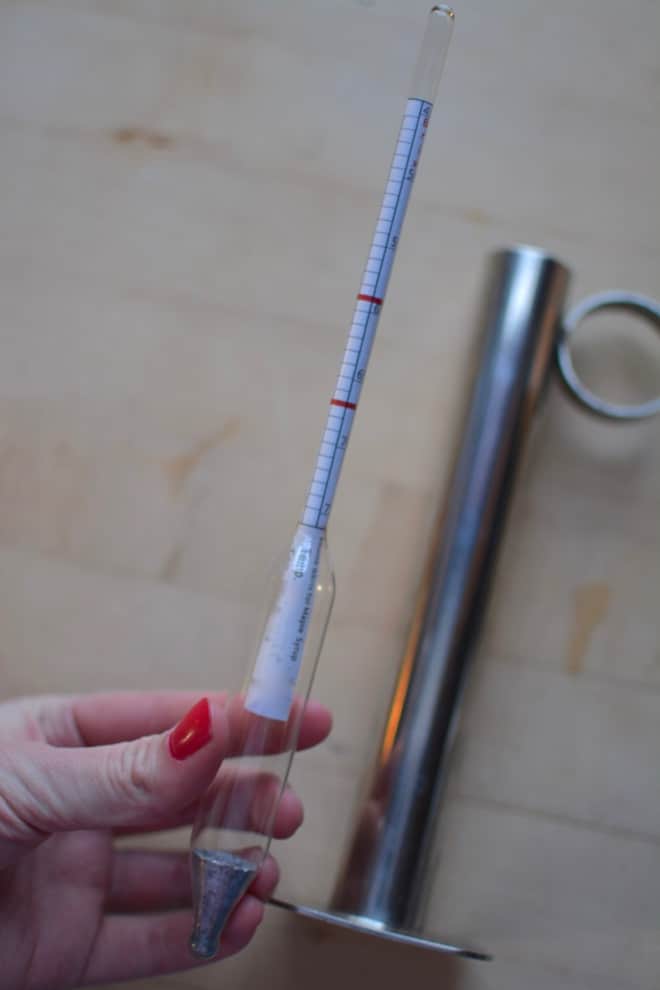
If you decide to purchase a hydrometer, keep in mind that there are different types of hydrometers for using in beer and wine making, so be sure you buy the type of hydrometer that is calibrated for syrup making. This one is perfect. Then make sure you have a hydrometer cup like this one as well. If you’d like to purchase both a hydrometer and the cup that you’ll need to use with it together in one kit, my friends over at Smoky Lake Maple have got you covered. Check out their hydrometer and cup combo right here.
Refractometer
If you wanna go a little-fancier, you could consider a refractometer. If you do, you have a choice of manual or digital. Either way, a refractometer does exactly what its name insinuates. It measures how light is refracted through your sugary, boiled-down sap to determine how high your sugar content is. Even one step better, many refractometers are more detailed than hydrometers in the sense that they can also measure the sugar content in your sap, right out of the tree.
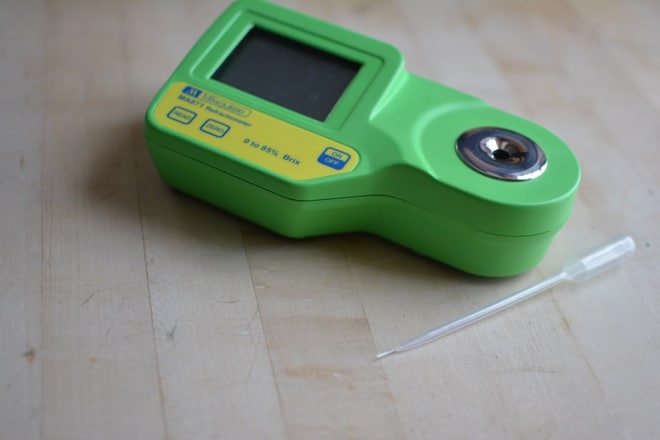
A few years ago, we upgraded from a hydrometer to a refractometer because we wanted to be able to measure both sap and syrup. We use it when we’re bottling syrup, but we also like using our refractometer to measure the sugar content of our sap before and after running it through our RO filter, to reassure ourselves just how awesome our RO is and how much money it’s saving us.
You’ll place a drop of sap or syrup in a little cup at the end of your refractometer then, with the manual option, hold it up to the light. With a digital refractometer–this is the one we have –you just push a button. As light reflects through your syrup, it’s refracted and the nifty tool in your hand tells you the sugar content of your syrup. You do want to zero out, or “reset” your refractometer with each reading, using water that is a similar temperature to the sap or syrup drop that you will be placing on it.
If on the other hand, you only want to measure the sugar content of your sap, you can save money by getting a refractometer that only measures on the lower end of the scale. But I personally want one refractometer that can measure everything I need to know… sugar content in sap as well as syrup. That’s why we own this refractometer. Both are fine choices, depending on what your needs are.
On the other hand, if you want a professional grade refractometer that is durable and as versatile as you’ll find anywhere, this top-end refractometer might be for you. Watch this video to see our refractometer and how I use it to measure the sugar content of my sap and my boiling syrup.
Murphy Cup
This tool is a nifty sort of a combination of others, in one place. You need to fill the cup with syrup, float a hydrometer in the cup—just as I described in the description of a hydrometer above—and read the dial on the cup. The dial tells you what your hydrometer needs to read, based on the temperature of your syrup. To have perfect syrup, you just want the dial to match the reading on your hydrometer. That’s all you need to do.
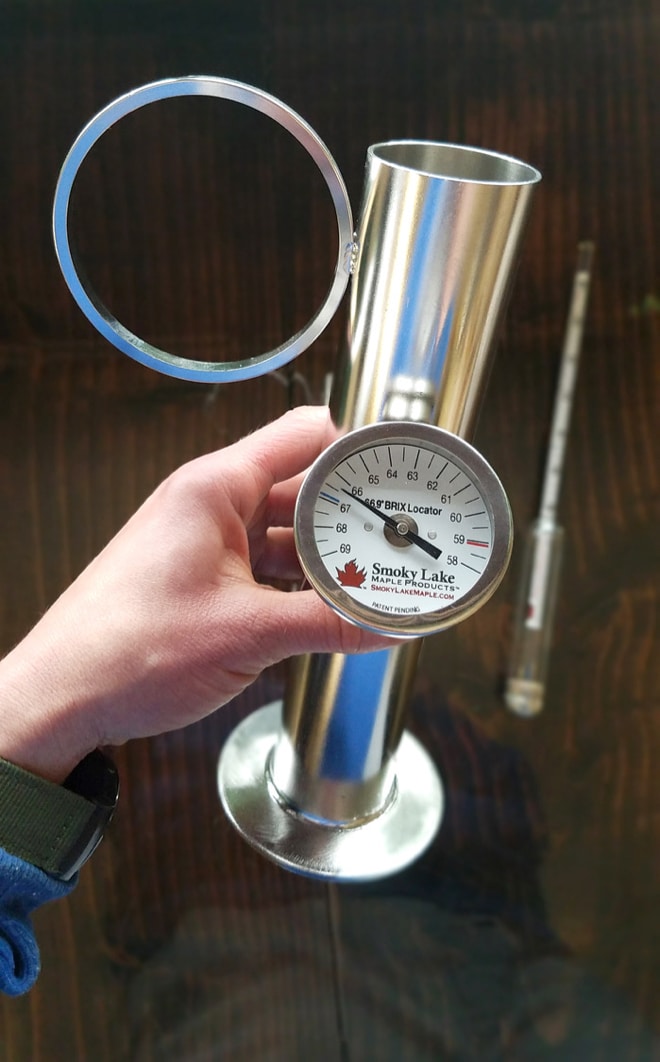
I love the ingenuity behind the Murphy Cup, and the smart inventors behind it run a great shop, full of products I often recommend to backyard sugarmakers. So whether you’re in the market for a nifty Murphy Cup or not, stop over to Smoky Lake Maple (and tell Jim & Angela I sent you :)).
If you want more maple-infused goodness…
Grab a copy of my book, Sweet Maple, for more tips on using these three tools and pretty much an answer to every question you come up with about backyard sugaring.
Every sugarmaker also needs a great maple recipe… sign up here and download ebooks and printable recipes. All resources are totally free, in my Resource Library for subscribers.
Or maybe you’d like some maple goodness in your kitchen without any effort at all… I can help with that too. Check out this amazing syrup. Use code SOULYRESTED and save $$ too!
Other articles about how to make syrup:
A list of all the products I recommend for sugarmaking.
Making maple syrup in your backyard, step by step.
Sugarmaking tips from the pros.
6 ways to outsmart squirrels on the sugarbush (or in your backyard sugarmaking).
Everything you need to know to make your own RO filter & save hundreds of dollars making your own syrup.

I know that there is nothing better for people than to be happy and to do good while they live. That each of them may eat and drink, and find satisfaction in all their toil—this is the gift of God. Ecclesiastes 3: 12-13
Pin this for later!
Click on the image below to pin this post.
Find out why SoulyRested was considered to be one of the Top 20 Must-Read Homesteading Blogs of 2018
and then one of the Top Homesteading Blogs of 2019 as well.
I’d love to connect!
To find me in some other neck of the woods, just click any (or every!) icon below:
